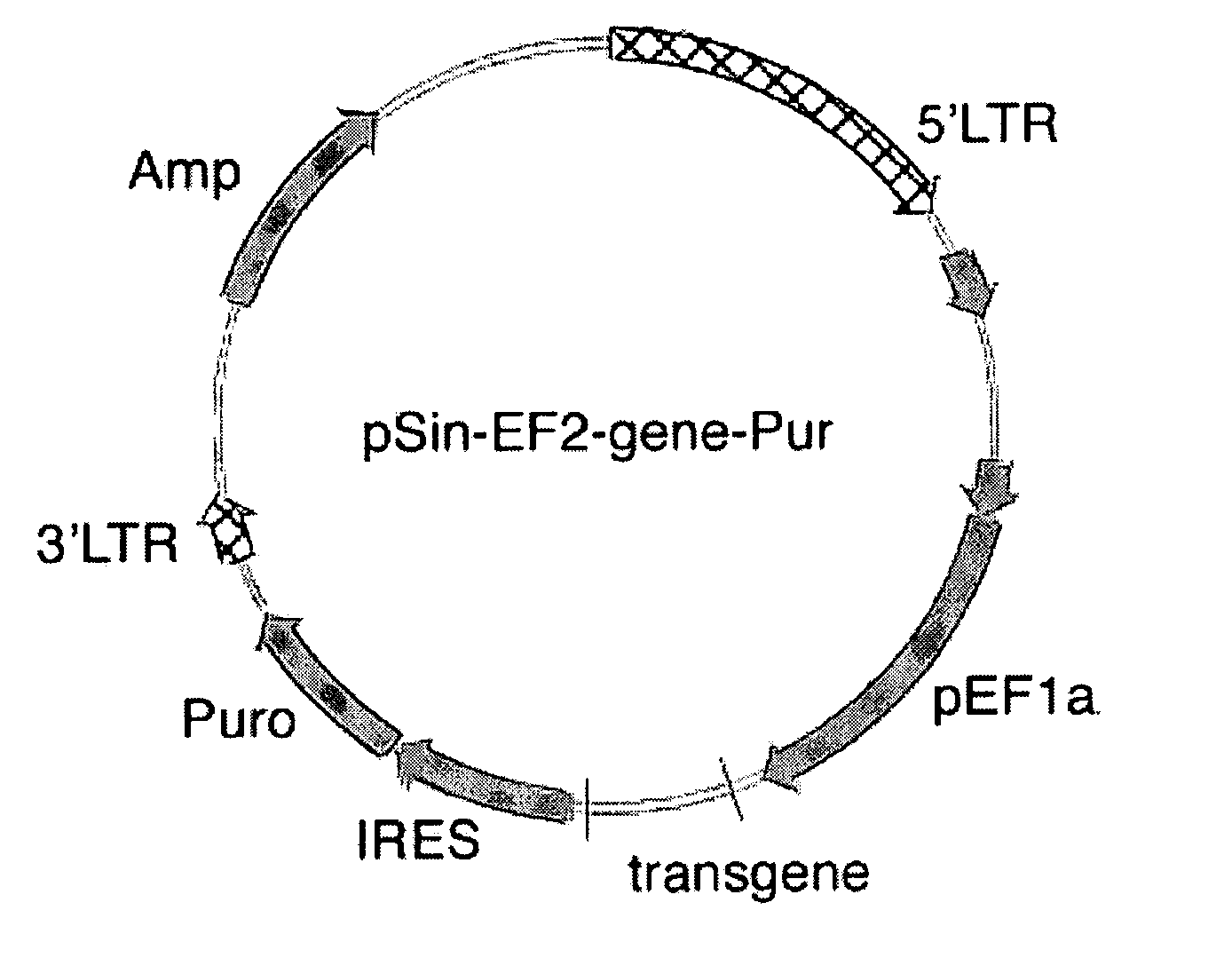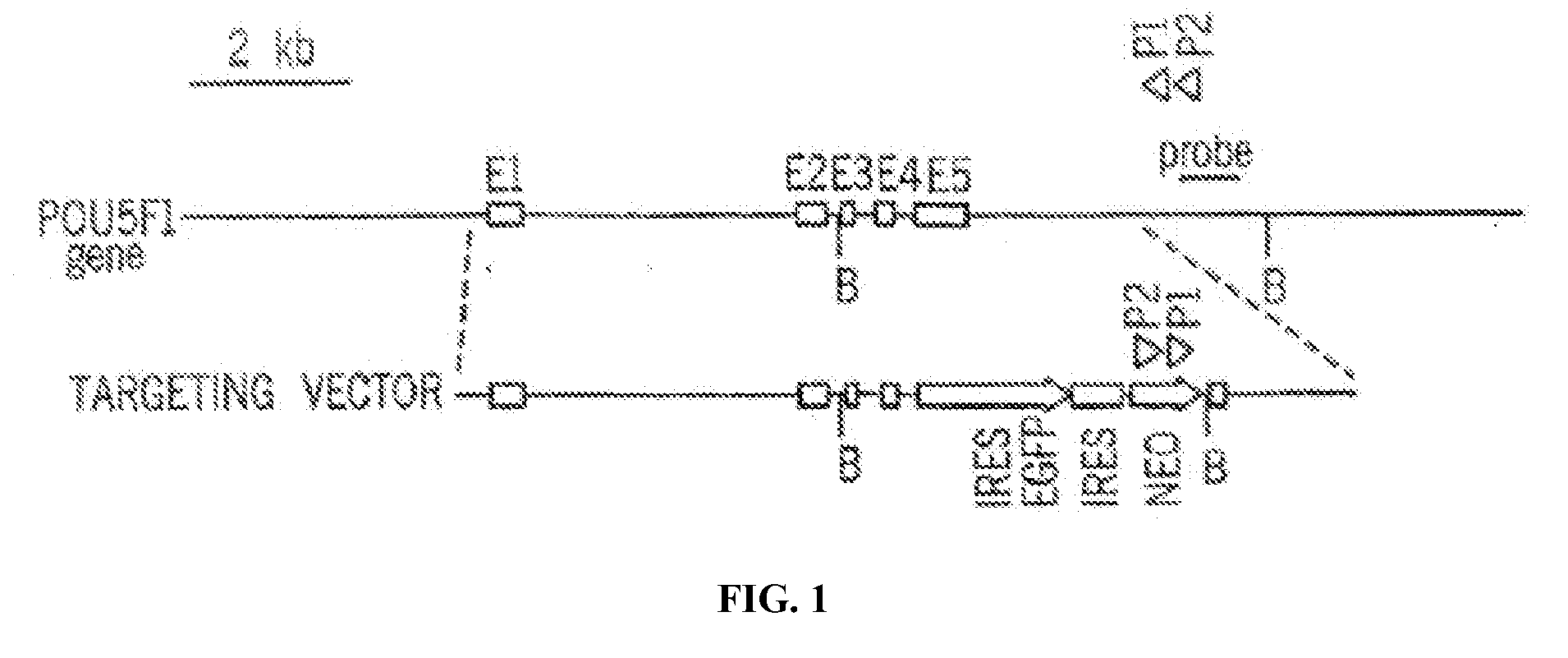Somatic cell reprogramming
a somatic cell and reprogramming technology, applied in the field of somatic cell reprogramming, can solve the problems of insufficient set of factors used to produce ips cells from differentiated mouse cells, insufficient set of factors used to reprogram human somatic cells, etc., to achieve the effect of increasing the potency of somatic cells, improving the efficiency of obtaining reprogrammed cells, and high nucleus to cytoplasm ratio
- Summary
- Abstract
- Description
- Claims
- Application Information
AI Technical Summary
Benefits of technology
Problems solved by technology
Method used
Image
Examples
example 1
Lentiviral Vector Packaging and Production
[0053]Transgene-expressing lentivirus vector was produced in 293FT cell lines (Invitrogen). 293T is a fast-growing, highly transfectable clonal variant derived from transformed 293 embryonal kidney cells, which contains the large T antigen for high-level expression of the packaging proteins that contribute to higher viral titers. For routine maintenance and expansion, these cells were cultured in 293FT medium (DMEM / 10%FBS, 2 mM L-glutamine and 0.1 mM MEM Non-Essential Amino Acids) in the presence of 500 μg / ml geneticin. For packaging, 293FT cells were collected by trypsinization. Following removal of trypsin by centrifugation, these cells were aliquoted into T75 flasks (15×106 cells / flask, and 6 flasks per construct) in 293FT medium without geneticin.
[0054]Co-transfection of lentiviral vector and two helper plasmids was carried out with Superfect® transfection reagent (Qiagen) immediately following cell aliquoting (lentiviral vector:MD.G:pCM...
example 2
Reprogramming of Myeloid Precursor Cells After Lentiviral Transduction and Expression of Potency-Determining Factors
[0056]To identify genes capable of reprogramming differentiated cells back to a state of pluripotency, efficient transduction of the cells is required. Inventors first tested the lentiviral transduction efficiency immediately after Percoll® purification of a human H1 Oct4 knock-in ES cells (FIG. 2).
[0057]H1.1 human ES cells (WiCell Research Institute; Madison, Wis.) were maintained on irradiated mouse embryonic fibroblasts (MEFs) in DMEM / F12 culture medium consisting of 80% Dulbecco's modified Eagle's medium (no pyruvate, high glucose formulation; Invitrogen; Carlsbad, Calif.) supplemented with 20% KnockOut serum replacer, 1% non-essential amino acids (Gibco), 1 mM L-glutamine, 0.1 mM β-mercaptoethanol (Sigma) and 4 ng / ml basic fibroblast growth factor (bFGF) (all from Invitrogen unless otherwise noted), as previously described (see Amit et al., Dev Biol. 227:271-278 (...
example 3
Reprogramming of Mesenchymal-Like Cells with a Limited Set of Four Potency-Determining Factors After Lentiviral Transduction
[0074]To identify a more limited set of potency-determining factors capable of reprogramming differentiated cells back to pluripotency, the above-identified methods were repeated with a combination of Pou5F1 (Oct-4), Nanog, Sox2 and Lin28. Inventors used the techniques described above to screen these potency-determining factors for their ability to reprogram cells.
[0075]A different cell type was used in this example to further demonstrate the utility of the methods. The cell type was a mesenchymal-like clonal cell directly differentiated from human H1 Oct4 knock-in ES cells, as described above. As used herein, “clonal” refers to a characteristic of a population of cells derived from a common ancestor (i.e., derived from a single cell, not derived from a cell aggregate). That is, in a “clonal population,” the cells display a uniform pattern of cell surface marke...
PUM
| Property | Measurement | Unit |
|---|---|---|
| Fraction | aaaaa | aaaaa |
| Fraction | aaaaa | aaaaa |
| Fraction | aaaaa | aaaaa |
Abstract
Description
Claims
Application Information
 Login to View More
Login to View More - R&D
- Intellectual Property
- Life Sciences
- Materials
- Tech Scout
- Unparalleled Data Quality
- Higher Quality Content
- 60% Fewer Hallucinations
Browse by: Latest US Patents, China's latest patents, Technical Efficacy Thesaurus, Application Domain, Technology Topic, Popular Technical Reports.
© 2025 PatSnap. All rights reserved.Legal|Privacy policy|Modern Slavery Act Transparency Statement|Sitemap|About US| Contact US: help@patsnap.com



